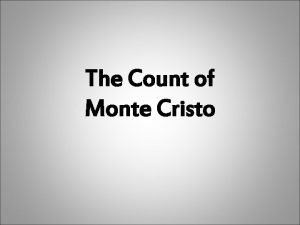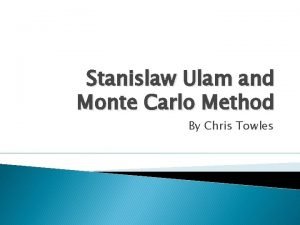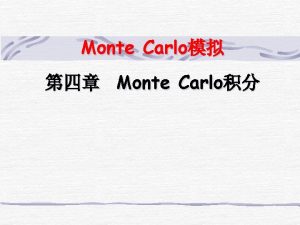OS 12 A141 Comparison of Monte Carlo Model


- Slides: 2

OS 12 A-141 Comparison of Monte Carlo Model Predictions with Tank Beam Spread Experiments Using a Maalox Phase Function Obtained with Volume Scattering Function Instruments 1 Prentice , 1 Laux , 1 Concannon Jennifer E. Alan E. Brian M. 1 1 2 Linda J. Mullen , V. Michael Contarino , Alan D. Weidemann 1 Naval Air Warfare Center Aircraft Division Code 456 Bldg. 2185 Suite 1100 22347 Cedar Point Road Unit 6, Patuxent River, MD 20670 Naval Research Laboratory Ocean Sciences, Code 7330, Stennis Space Center, MS 39529 -5004 2

Introduction Research Background PROTOCOL ØConstruction of Table Top VSF Meter. ØMeasurement of extremely small angle (0. 1º to 2º) scattering – 50 m polystyrene microspheres ØMeasurement of small angle (1º-17º) scattering – 10 m polystyrene microspheres ØComparison of experimentally measured and Mie Theory predictions ØMeasurement of Maalox – NAVAIR Table Top & Hydro. Beta ØMeasurement of Maalox Beam Spread Function – NAVAIR Tank ØComparison of NAVAIR Tank observation and Monte Carlo Simulation using the various ’s RESULTS 1) Successful prediction of the experimental results verifies that both the Monte Carlo simulation realistically predicts photon scatter and that the shape of the experimentally measured phase function ( ) is acceptable for the attenuating agent used. 2) New measurements made with Hydro. Beta spanning the range from 5º to 170º under parallel conditions of single and multiple scattering with Maalox accurately match NAVAIR results at angles less than 20º. NAVAIR tank results were combined with the Hydro. Beta to yield a measured VSF between 0. 1º and 90º. SIGNIFICANCE Using this new measured VSF in the Monte Carlo Model demonstrates the substantial importance of having accurate VSF measurements out to 90º in order to simulate Li. DAR system performance in the forward direction under conditions of multiple scattering as is characteristic of natural coastal and ocean waters. CONCLUSION Accurate in situ characterization of the VSF may play a dominant role in Li. DAR performance prediction. Measure, Verify, & Compare – Maalox Phase Functions An Accurate VSF – Essential to Predicting Multiple Scattering Behavior Acknowlegements & References NAVAIR Internal Research Grants in Electro Optic Sensors Division, the Middle Atlantic Research Consortium (MARC) Program through the Office of Naval Research (ONR), and PMA 264 provided the primary funding sources for this research. The authors acknowledge the collaborative work throughout the program of Dr. Richard Billmers of R. L. Associates, Langhorne, PA and the support of AMPAC, Inc. North Wales, PA. We thank Dr. Jon Davis for assistance in theoretical development of the Monte Carlo Model and verification of the Mie code. Hydro. Beta Data provided in conjunction with HOBI Labs, Inc. Marina, CA. Bohren C. and Huffman D. , 1998, Absorption and Scattering of Light by Small Particles, John Wiley & Sons, pp. 82 -129. Concannon B. and Davis J. , 1999, Results of a Monte Carlo investigation of the diffuse attenuation coefficient, Applied Optics, Vol. 38, No. 24, 5104 -5107. Laux A. , et al. , (In Press), Closing the Loop-The a, b, c’s of Oceanographic Lidar Predictions, Journal of Modern Optics, pp. 13. Petzold T. , 1972, Volume Scattering Functions for Selected Ocean Waters, Scripps Institution of Oceanography, Visibility Laboratory, San Diego, California, pp. 25 -27, 38, 64 -65.



